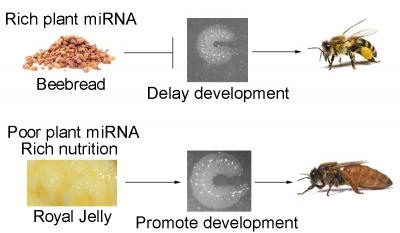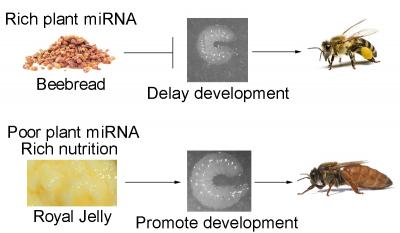
Credit: Xi Chen
Honeybee larvae develop into workers but not queens, in part, because their diet of beebread/pollen is enriched in plant miRNAs. While miRNAs are generally negative regulators of gene expression in eukaryotes, they also negatively regulate larval development when honeybee larvae consume beebread/pollen and take up plant miRNAs. Xi Chen and Chen-Yu Zhang's group in Nanjing University, report this finding on August 31, 2017 in PLOS Genetics.
How caste has formed in honeybees is an enduring puzzle. Although queens and workers are genetically identical, queens are reproductive and have a larger body size, develop faster and live longer than workers. Prevailing view is that differential larval feeding determines caste differentiation: royal jelly stimulates the differentiation of larvae into queen, whereas beebread and pollen consumed by the rest of the larvae lead to the worker bee fate. However, it is still not fully understood how alterations in diet modify so thoroughly the developmental trajectory of honeybees.
In previous studies, Chen-Yu Zhang's group has reported a striking finding that plant miRNAs are ingested from plant diets and pass through the gastrointestinal tract, enter into the blood, accumulate in tissues and regulate endogenous gene expression in animals. Their findings suggest that ingested exogenous miRNAs can regulate endogenous gene expression and reshape animal phenotypes. Interestingly, since the components of beebread/pollen are mainly plant materials and royal jelly is a glandular secretion of nurse bees, the diets for worker- and queen-destined larvae are differentially derived from plant- and animal-sources. Therefore, Xi Chen, Chen-Yu Zhang and colleagues decide to investigate if miRNAs from different larval diets may have distinct impacts on honeybee development.
Here, they report that plant miRNAs are more enriched in beebread/pollen than in royal jelly. While plant miRNAs of beebread/pollen are fed to larvae, they cause developmental delay and reductions in body and ovary size in honeybees; in contrast, miRNAs in the royal jelly are not sufficient to reach a functional level, therefore queen-destined larvae evade this regulation. Mechanistic studies reveal that amTOR, a stimulatory gene in caste differentiation, is the direct target of miR162a. Interestingly, ingested plant miRNAs have a similar inhibitory effect on fruit fly development, even though fruit fly is not a social insect. In summary, this study uncovers a new mechanism that plant miRNAs in larval diet of worker bees delay caste differentiation and keep ovaries inactive, thereby inducing sterile worker bees.
The findings of this study are important for the following reasons:
1) This study reveals a previously uncharacterized role for RNA in beebread/pollen instead of protein, sugar and hormone in royal jelly to influence caste differentiation. The theories about honeybee caste formation need to be re-examined from a new angle besides the traditional focus on royal jelly and its components. Overall, the positive effect of royal jelly and negative effect of plant miRNAs on honeybee development may maintain the stability of the colony's social order in a coordinated manner. From this standpoint, plant miRNAs are not accidentally included as a part of the food but instead collected with specific purpose, probably for the survival of the honeybee colonies.
2) This study provides additional support for the concept of horizontal miRNA transfer across species and kingdoms. Ingested plant miRNAs can even influence the developmental fate and reshape phenotypes in honeybees and fruit flies. Transfer of miRNA from one species to another may be a conventional mechanism to facilitate cross-talk and interspecies communication.
3) In an evolutionary sense, the role of plant miRNAs in regulating honeybee development may offer valuable hints for our understanding of cross-kingdom interaction and co-evolution. In the nature, entomophilous plants develop characteristics that are attractive to honeybees for pollination, while anemophilous plants use wind to spread pollen and produce pollen that is less adapted to insects. Is it possible that plant miRNAs are more enriched in the pollen of entomophilous plants than in anemophilous plants? If so, the selection of food sources by honeybees indicates an extraordinary evolutionary adaptation for colony success through partnership between two interacting organisms. Further studies in this new field may shed light on the impact of food consumption on the evolution of ecosystem. For example, it is worth to investigate if the large-scale loss of honeybee colonies may be a consequence of the global changes of plant communities.
###
The researchers of this project include Kegan Zhu, Minghui Liu, Zheng Fu, Zhen Zhou, Yan Kong, Hongwei Liang, Zheguang Lin, Jun Luo, Huoqing Zheng, Ping Wan, Junfeng Zhang, Ke Zen, Jiong Chen, Fuliang Hu, Chen-Yu Zhang, Jie Ren, Xi Chen of State Key Laboratory of Pharmaceutical Biotechnology, NJU Advanced Institute for Life Sciences, Jiangsu Engineering Research Center for MicroRNA Biology and Biotechnology, Nanjing University, Nanjing 210093, China; College of Animal Science, Zhejiang University, Hangzhou 310058, China; Model Animal Research Center and MOE Key Laboratory of Model Animals for Disease Study, Nanjing University, Nanjing 210061, China; Cold Spring Harbor Laboratory, Cold Spring Harbor, NY 11724, USA. Xi Chen and Chen-Yu Zhang at Nanjing University conceived and designed the experiments; Jie Ren at Cold Spring Harbor Laboratory contributed significantly to analysis and manuscript preparation; Rearing of honeybees was performed in Fuliang Hu's lab at Zhejiang University; Rearing of fruit flies was performed in Jiong Chen's lab at Nanjing University.
Media Contact
Xi Chen
[email protected]
86-258-968-1323





